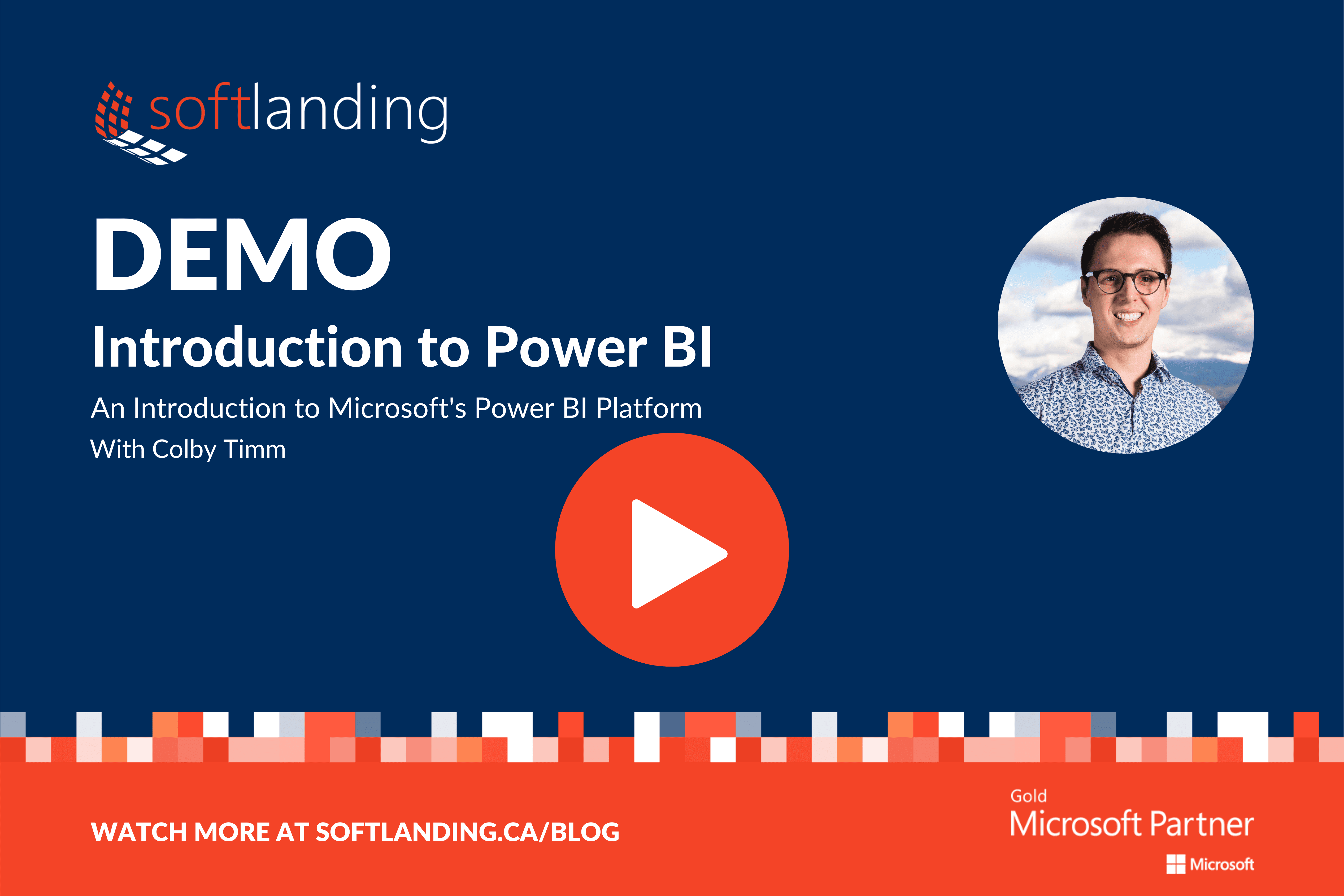Here is a short demonstration of Microsoft’s Power BI platform and how you can use it to take control of your data to build visually appealing and interactive reports that can be accessed from anywhere.
Transcript
Hello, everyone, and welcome to Introduction to Power BI. My name is Colby Tim, and I’m a software developer and data analyst at Softlanding Solutions. Today, we’re going to be looking at playing around with Power BI, getting an introduction to the overall look and feel of Power BI as well as bringing data to manipulate in Power BI. So without further ado, let’s get started.
So the first thing you want to do is we’re going to have to get some sort of data to bring into our Power BI report. And so today we’re actually going to be using kaggle.com. If you’re not familiar with kaggle.com, it’s just a data science service that’s owned by Google. And you can find a lot of data sets here to play around with.
Today, we’re going to be using the Netflix shows one. So if you want to find it, you just go to kaggle.com, sign into an account, click on data and you’ll see it’s one of the most popular ones around. So Netflix movies and TV shows. And then all you have to do is click download and it will download the CSV for you. So once you’ve done that, it’ll download this archive zip file and if you hit extract, you’ll get this CSV file right over here. We’ll just leave that for now. The next thing you want to do is to download Power BI desktop.
And so if you head over to the Microsoft store and you hit search, just search Power BI and then click on Power BI desktop and download that. You’ll have the latest version of Power BI desktop. So once you’ve got that, go ahead and launch Power BI desktop. It takes a few seconds to launch. Once we’ve launched Power BI desktop, we’re going to want to bring in our data so that we can create a report based on it. So to import data and this might look very familiar to you if you’ve used any of Microsoft’s office products, like Word or PowerPoint, you know, you’ve got on top, you’ve got your ribbon. So that’s a very familiar looking interface. So we’re going to hit “Home” under home, hit “Get Data” and we’re going to hit “Text/CSV”. All right, and the next thing you want to do is click on the data that you’re going to import, in our case, the Netflix CSV. And so that’s going to bring up this dialogue to give you a preview of your first few rows.
Power BI is pretty smart, so it gives you an idea of the type of file that you’re bringing in. So, for instance, the deliminator, in our case, it’s a comma-deliminated file, but you might have something that semicolon-deliminated or tab-deliminated. And so what this does initially, it just detects that based on the first two hundred rows. But I can also select and say, I want you to base this off to my entire dataset to ensure that it follows this format. So in our case, it does.
So what you can do is you can hit “Load”, but for our case, we’re actually going to transform the data. If you’re not familiar with transforming data, basically we’re going to help either cleanse the data, if there’s any data that might be an issue for us, we can also define the types of data types for each column. So the first thing I want to do is in the query area on the left here, I want to rename my table so you can either double click on this and another way is to right click and rename and then I’m just going to call my table Netflix. And so in the center here, this is my data that I’m bringing in. And so you’ll be able to look at the types of columns that we’re bringing in and some sample data. What I like to do is maybe rename these so that they’re capitalized.
Maybe we want to just call this I.D. instead of show ID. Rename this “Cast,” “Country,” “Date added”. And you’ll notice that it has this ABC, what that means is it’s it’s defined this as a text area. If you click on that, you’ll notice some different data types that were offered. So because this is a date column. I want to make it a date so it knows its a type date instead of a type text.
In our case, I’m going to leave year as a text, but let’s just say you made it a date and you realized that was a mistake. So you’ll notice how it’s formatting it. It’s made it a “year, month, day.” If you notice on the right here, there’s these applied steps, these are all the different steps that you’re doing to format your data, to transform it. So if you go and hit the X beside a step after you select it. So depending on what step you want to do, you’ll undo that change. So that’s a great way of, you know, if you made a mistake, it’s really easy to go ahead and undo it as well as undoing it in the future as well. I think everything else is looking pretty good. I’m just going to rename. Everything here. Um, let’s go ahead and maybe call this “Genre,” and, “Description”, and I think we’re OK right now.
So if you’re happy with how you’ve transformed your data, you go ahead and you can click this close and apply. What you can do is, you have two options, you can close and apply, which will close this entire window, or you can just apply it. I’m just going to apply it for now. The reason I’m doing that is, I know there’s going to be an error when I try to load this data. There are two columns that will cause this error. Actually one column.
If you click view errors, what will do that will create a a table to show the errors that you’re that have occurred. So it may take a few seconds to load. All right, so now that our errors have loaded or one error has loaded, we can take a look at what’s causing this error. In this case, it’s actually caused by this date added. Then click on it, you’ll notice that date added is actually TV-PG, which obviously is incorrect.
So to remedy the situation, I go ahead and click on my Netflix table on the left hand side here and click on that. And I can say, I can remove my errors. I can decide to remove my errors. In this case, I don’t need that particular item. So I’m going to remove it. Before I do remove it, I think I’m going to also change this ID field to a whole number. Which will most likely cause another error, and the reason there’s another error there is this particular item, its ID is “Flying Fortress”, which is also incorrect.
So I’m going to have to remedy two errors. And again, click on the table there, remove errors. And that’ll go ahead and remove those errors from my table. If you want to get rid of this error query here, go ahead and right, click and just say delete group. We’ll get rid of that, so you don’t need to have that there anymore, and then we’re going to go ahead and hit close and apply. So it’ll take a few seconds to apply your changes.
And now on the right here, you’ll notice the table has been imported with the columns that we’ve renamed and also cost as we wanted to. So now that we have everything put together just to provide an overview of Power BI. So I talked about the ribbon and there are various aspects of the ribbon that we won’t go into detail today, but just be aware that there are different types of things you can do in the ribbon itself.
On the left-hand side here we have these three little buttons. The first one is our reports view that we’re in. The second one is called data. If you click on that, that will just show you all your data that you have. So on the right here we’ve selected our Netflix table, but if you had a variety of other tables you’d be able to select them as well and view the data in there. And then, the last one is our model view and so model views where you can create relationships between your tables. So if you have other tables here, you can create a relationship between them using this view. Which we won’t be using today for this particular example.
Alright, so the first thing we want to do is we’re going to start building our report. And to build our report we’ve got on this right pane here called visualizations. This allows us to add different visualizations to our report. So the first one that we’ll probably add, that’s a very basic visualization is this table visualization. So if you click on it, you’ll notice it brings in this object over here. What we need to do is we need to add values to that object. So as you have this selected, if you go to your right here and you select a value. So let’s just say we are interested in looking at the title, so check that. And we are interested in the director and the description. So I’m just going to drag this out so I can see my tables a bit better. And you’ll notice it’s bringing in the title, the director and the description throughout my table here and you can sort this. So let’s just say I want to sort this by title. So if I click on ‘title’ it’ll sort it now by title in descending. So it’s going to show the numbers first and then it will go into the letters.
Alright, so this is starting to look good. But now let’s just say we’re interested in being able to filter that by rating OK, so let’s just say we’re interested in filtering by rating. So if I click on that, if I click on rating, you’ll notice that it will just import it as a table. That’s the default. But I don’t want this to be a table. I want this to be a filter in some way.
So there are things called ‘slicers’. And so what a slicer does, and slicer should be on the left of table, you click on that and it allows you, it creates this kind of slicer view. And you’ll notice if I click on R for instance, it’ll filter everything or start filtering everything, that’s R rating. Or TV-14. But the one thing you’ll notice is, oh, I can only select one item at a time. That’s not very useful, right? So slicer has these variety of different options that you can do.
So on the right here in visualizations, this is where you’ll get this little paint symbol and that is the format area and so this is where you can format that object. So in if you click on selection controls here you can define if you want people to be able to do multi select or single select etc. So in this case it does allow multiselect but you have to hold down control. So if I hold down control and I select you’ll notice it’s allowing me to multiselect. But let’s just say I want to make it a little more intuitive. I deselect that. I can actually allow people to just click and select. And so this little eraser up here will deselect well, select everything, so it will get rid of all those filters. So yeah, just be aware of that.
Something worth mentioning with when it comes to filters, sometimes it can be confusing. You’ve applied a lot of filters to something on your report and you’re not sure water filters or affecting that report. So let’s just say I’ve got two filters applied to this table. If I go to the table and I click on this or hover on this filters kind of button, you’ll notice that it says that there’s a rating that’s been applied to this table of TV 14 and TVG, which you can notice I’ve clicked on those two items in my slicer here, so that’s just a great way of kind of troubleshooting. Sometimes it can be, it can be a little confusing as to, OK, I’ve created this table, but it’s being filtered in some way, so that’s a great way of troubleshooting to see what is affecting your different types of objects. Or visualizations I should say.
Alright, so the next thing we want to do is now that we’ve got our slicer here. And another thing to point out about slicers is there’s this drop down so you can do either a list which we have right here or drop down. So dropdowns just the drop down list. The nice thing with dropdowns is if space is an issue, and you want to make it a little more to take up less space, this is great way of doing that. And you still have the same functionality that you had previously, is just in a drop down list.
So the final visualization that we’re going to add to our report is we want to add a pie chart. And so what we want to do is we want to get an idea of how many of our movies are being directed by, sorry how many movies we have in our list per year. So this kind of will give us an idea of you know our years. And so we’re going to do it by year in our legend and we’re going to use our ID column, ’cause I the ID column points to particular movies. So if I had sorry add ID column to value so you can just drag it in. And you’ll start to notice that here it’s starting to separate everything by year or on movies by year, and so that looks really nice. But maybe we want to add a few more details to that so I could, you know, I can hover over here and I can see. Oh look, there is 830 movies that are being counted for 2016, but what does that actually mean?
So perhaps, but you also want to do is maybe rename this instead of ID. Maybe want to say ‘amount of movies.’ OK, so now if you hover over that you’ll notice that it says amount of movies. But let’s see if we want to add more detail to this. So to add detail, you just drag it in.
So perhaps we want to also add the count of directories in that tooltip. So I’m just going to add director here and I’m going to say count distinct. And so I’ll leave the tooltip as that value. So now we’re not hover over here. You’ll see there in 2016, there were 830 movies, but there are also 573 distinct directors of those movies. And so this is a great way of, you know obviously, breaking down your data in a pie chart.
But sometimes it’s, I mean, it’s nice to look at this top view, but what are those movies? I want to know what those movies are. So just like the slicer above, this works as a filter as well. So if I wanted to look at movies in 2016 in more detail, if I click on that it will filter this table by those movies. And so now I can actually go ahead and look at, here where all those movies that were done in 2016.
So hopefully you found this video useful. It’s just a very brief overview of getting started in Power BI and getting you familiar with the overall look and feel of Power BI. We learned about how we could bring in a simple CSV file as well as transform that data and then finally, once you’ve brought in all that data, you can now start to add some visualizations to it. And play around with the look and feel of the report.
Thanks for dropping by and I look forward to catching you in the next one. Bye for now.




